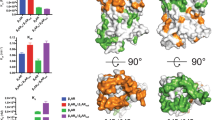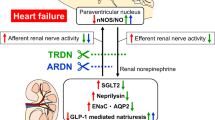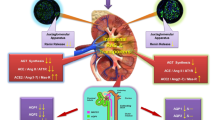Abstract
Adrenergic receptors were first classified into two classes—α and β—on the basis of the relative pharmacological potencies of agonist compounds1, and this classification has been supported by subsequent studies. In some tissues, such as the heart and liver2,3, they exert similar physiological responses, and in other tissues, such as the uterus and vasculature, they have opposing roles4,5. The occurrence of both classes of receptor in the same tissue leads to the problem of what determines whether the overall response observed is α-type or β-type, as adrenaline and noradrenaline bind to both receptor classes. Furthermore, direct binding studies have demonstrated that the two receptor classes are distinct and separate entities6. We show here that stimulation of α-receptors in renal membranes causes a specific decrease in the affinity of the agonist compound isoprenaline for β-receptors in the same membranes. This demonstrates that interactions occur between renal α- and β-adrenergic receptors. Such interactions may modulate the response of the kidney to sympathetic stimulation.
This is a preview of subscription content, access via your institution
Access options
Subscribe to this journal
Receive 51 print issues and online access
$199.00 per year
only $3.90 per issue
Buy this article
- Purchase on SpringerLink
- Instant access to full article PDF
Prices may be subject to local taxes which are calculated during checkout
Similar content being viewed by others
References
Ahlquist, R. P. Am. J. Physiol. 153, 586–600 (1948).
Watanabe, A. M., Hathaway, D. R., Besch, H. R. Jr, Farmer, B. B. & Harris, R. A. Circulation Res. 40, 596–604 (1977).
Exton, J. H. Biochem. Pharmac. 28, 2237–2240 (1977).
Borda, E., Sauvage, J., Sterin-Forda, L., Gimino, M. F. & Gimeno, A. L. Eur. J. Pharmac. 56, 61–67 (1979).
Fleisch, J. H. Blood Vessels 11, 193–211 (1974).
Wood, C. L., Caron, M. G. & Lefkowitz, R. J. Biochem. biophys. Res. Commun. 88, 1–8 (1979).
Woodcock, E. A. & Johnston, C. I. Hypertension 2, 156–161 (1980).
Scatchard, G. Ann. N.Y. Acad. Sci. 51, 662–672 (1949).
Hegstrand, L. R., Minneman, K. P. & Molinoff, P. B. J. Pharmac. exp. Ther. 210, 215–221 (1979).
Limbird, L. E. & Lefkowitz, R. J. Proc. natn. Acad. Sci. U.S.A. 75, 228–232 (1978).
Weiland, G. A., Minneman, K. P. & Molinoff, P. B. Nature 281, 114–117 (1979).
Bird, S. J. & Maguire, M. R. J. biol. Chem. 253, 8826–8834 (1978).
Watanabe, A. M. et al. J. biol. Chem. 253, 4833–4836 (1978).
Maguire, M. E., Ross, E. M. & Gilman, A. G. Adv. Cyclic Nucleotide Res. 8, 1–83 (1977).
Beck, N. P., Reid, S. W., Murdaugh, H. V. & Davis, B. B. J. clin. Invest. 51, 939–944 (1972).
La Grange, R. G., Sloop, C. H. & Schmidt, H. E. Circulation Res. 33, 704–712 (1973).
Johnson, J. A. et al. Am. J. Physiol. 230, 410–418 (1978).
Pettinger, W. A., Keeton, T. K., Campbell, W. B. & Harper, D. C. Circulation Res. 38, 338–346 (1976).
Morel, F., Chabardes, D. & Imburt-Teboul, M. Proc. 7th int. Cong. Nephrology, Montreal, 209–216 (Karger, Basle, 1978).
Author information
Authors and Affiliations
Rights and permissions
About this article
Cite this article
Woodcock, E., Johnston, C. α-Adrenergic receptors modulate β-receptor affinity in rat kidney membranes. Nature 286, 159–160 (1980). https://doi.org/10.1038/286159a0
Received:
Accepted:
Issue date:
DOI: https://doi.org/10.1038/286159a0



